- For other places with the same name, see Angola (disambiguation).
Angola is a beautiful nation in Central Africa endowed with beautiful waterfalls, rivers, national parks, and coastlines. There is plenty to do and see here.
Regions[edit]

| Greater Luanda The population centre of the country and home to the capital Luanda |
| Northern Angola Northern area mostly bordering Democratic Republic of the Congo with significant areas of rainforest |
| Central Angola A series of irregular, high escarpments which drop steeply to the nation's best beaches on the Atlantic coast |
| Southwest Angola The most arid region of the country with savanna plains and the northern continuation of the Namibian desert |
| Eastern Angola The "empty" part of Angola, savannah plains intersected by five great rivers |
| Cabinda Northern exclave on the Atlantic ocean with a huge proportion of the nation's oil reserves, beautiful rainforests, and an active secessionist movement |
Cities[edit]
- 1 Luanda — the massive, overcrowded, chaotic, and incredibly expensive capital of the country, filled with nightlife and culture, a jarring mix of wealthy expats in the oil industry and the masses of destitute migrants from the rest of the country.
- 2 Benguela — the most tourist-friendly city in one of the world's least touristy countries, with a strong Carnavale tradition, pretty oceanfront, and by the nation's best beaches.
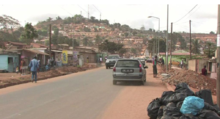
- 3 Cabinda — the wealthy capital of oil-rich Cabinda Province
- 4 Huambo — the center of the Ovimbundu region, one of Angola's larger cities that suffered greatly during the civil war, surrounded by much natural beauty.
- 5 Lobito — a beachfront city, basically part of Benguela, which is the epicentre of Carnavale celebrations.
- 6 M'banza-Kongo
- 7 Lubango — a good base for exploring the mountainous escarpment in the center of southern Angola.
- Malanje — a destination owing to its proximity to tourist attractions like Kalandula Falls, Pungo Andongo, and Cangandala National Park.
- Menongue — a small city in the remote southeast, the terminus of the Moçâmedes Railway, from Namibe.
- Namibe — beachfront capital of the desert southwest, and jumping off point for exploring Iona National Park, and excursions to meet Khoisan peoples.
Other destinations[edit]
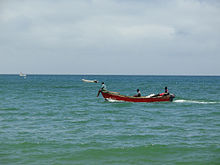
- 1 Cangandala National Park — Angola's most famous park, a reserve designed to protect the critically endangered Giant Sable antelope, which is the national symbol of Angola.
- Floresta do Maiombe — a rainforest reserve in Cabinda Province with very high biodiversity and many rivers and waterfalls.
- Great Escarpment — the steepest mountains of Angola, with scenic drives (4x4 only), opportunities for adventurous hikers, and some spectacular views, most notably the Tundavala Gap.
- 2 Iona National Park — adjacent to Namibia's Skeleton Coast, a sparsely inhabited desert region, accessible but short on infrastructure, home to some isolated and very traditional semi-nomadic peoples.
- 3 Kalandula Falls — one of Angola's most famous sights, near Malanje.
- 4 Kissama National Park — Angola's most accessible park, near Luanda, with accommodations for tourists.
- 5 Mussulo Island — a beautiful extension of land in the south of Luanda that's famous for its natural beauty; explore some of its local cuisine such as ‘pirão’, funge, and moamba.
- 6 Pungo Andongo — large, unusual black rock formations, reasonably easy to visit from Luanda or Malanje.
- Sumbe Caves — beautiful caves in a jungle-filled canyon near the small city of Sumbe, about four hours south of Luanda.
Understand[edit]
The people of Angola are stoics. They have a deep understanding of patience, and avoid blaming the difficulties the country faces on the fact that there was war. In fact, Angolans behave as if there was no war although it is deeply rooted in every Angolan. Music is the heart and soul of Angolans, it can be heard anywhere and they use anything as an excuse to party. The country has a wide range of music, mainly Kuduro, Kizomba, Semba, and Tarrachinha, the latter being more sensual than all the others. In all, it is safe to say that Angolans are fun and loving people with a thirst for more of what life has to give.
Since the end of the brutal, horrific Angolan Civil War in 2002, the Angolan government is keen on improving the country's international image and opening up Angola to the world. Tourism is still in its nascent stages and it will take some time for things to get back to normal. The country's national park system was devastated during the war, with rampant poaching leaving Angola with relatively scant megafauna compared to its African peers.
The country's tourism industry has been steadily growing and attracts 500,000–600,000 people each year. Angola shares borders with Namibia, Zambia, and the two Congos.
History[edit]
Before colonial rule, northern Angola was home to the Kingdom of Kongo, and the capital of it was M'banza-Kongo. The Kingdom of Kongo also had several vassal states, including the kingdoms of Ndongo and Matamba, which would unite into a powerful entity in its own right under the rule of Queen Nzinga in the 17th century.
Angola as a Portuguese colony (15th century - 1975)[edit]
A Portuguese explorer, Diogo Cão, first discovered the country in 1484. Sometime later, the Portuguese established a trading post at the mouth of the Congo River. The Portuguese colonialists gradually expanded their control over the region, establishing a colonial administration and exploiting Angola's resources for economic gain.
As a Portuguese colony, Angola's society and economy underwent significant transformations. The Portuguese aimed to exploit the region's vast natural resources, including minerals, timber, and agricultural products. They introduced commercial farming, particularly in the fertile northern part, focusing on cash crops such as coffee, cotton, and sisal. The Portuguese even traded enslaved people for plantations, mainly to Brazil.
The Portuguese also forced their language, culture, and religion on the people of Angola. The official language became Portuguese, and the school system was designed to integrate Angolans into Portuguese culture. Christianity, primarily Roman Catholicism, was pushed, resulting in widespread Angolan conversion. Furthermore, the influence of Portuguese culture and religion eroded native African beliefs and practices.
As the winds of change blew over Africa in the mid-twentieth century, nationalist movements in Angola arose, demanding independence from Portuguese control. The most visible of them were the Popular Movement for Angolan Liberation (MPLA), the National Front for Angolan Liberation (FNLA), and the National Union for Total Independence of Angola (UNITA). These movements fought for independence by armed confrontation, resulting in a lengthy and violent fight.
Finally, on November 11, 1975, Angola gained independence, and the MPLA established a socialist government with support from the Soviet Union and other socialist countries.
Angolan Civil War (1975 - 2002)[edit]
Following independence, Angola was divided into three major factions: the Marxist-Leninist People's Movement for the Liberation of Angola (MPLA), the National Union for Total Independence of Angola (UNITA), and the National Liberation Front of Angola (FNLA). Each faction had a different vision for the country's future and tried to capture power.
The civil war swiftly grew into a full-fledged struggle marked by guerilla fighting, military offensives, and massive human rights violations. The war's impact on civilians was severe, with millions displaced and massive casualties. The nation's infrastructure was severely damaged, and the war significantly influenced Angola's socioeconomic progress.
Present day (2002 - present)[edit]
Since the conclusion of the Angolan Civil War, the country's economy has grown, and the political situation has stabilised considerably; however, the government is still feeling the damaging effects of the civil war. Poverty, malnutrition, and disease are widespread, the standard of living for many Angolans is poor, and the country suffers from high corruption and inequality. Over 70% of Angolans live below $3.20 a day.
In August 2006, a peace treaty was signed with a faction of the FLEC, a separatist guerrilla group from the Cabinda exclave in the North, which is still active. About 65% of Angola's oil comes from that region.
Since 2017, the government has made fighting corruption its main agenda. Numerous corrupt politicians have either been jailed or are awaiting trial.
Climate[edit]

Like the rest of tropical Africa, Angola experiences distinct, alternating rainy and dry seasons.
The coastal strip is tempered by the cool Benguela Current, resulting in a climate similar to coastal Peru or Baja California. It is semiarid in the South and along the coast to Luanda. There is a short rainy season lasting from February to April. Summers are hot and dry, while winters are mild. The northern part has a cool, dry season (May to October) and a hot, rainy season (November to April). In the interior, above 1,000m (3,300 ft), the temperature and rainfall decrease. The interior highlands have a mild climate with a rainy season from November through April followed by a cool dry season from May to October.
The heaviest rainfall occurs in April, and is accompanied by violent storms. The far north and Cabinda enjoy rain throughout much of the year.
Electricity[edit]
Officially 220 V, 50 Hz. Outlets are the European standard CEE-7/7 "Schukostecker" or "Schuko" or the compatible, but non-grounded, CEE-7/16 "Europlug" types. Generally speaking, U.S. and Canadian travellers should pack a transforming adapter for these outlets if they plan to use North American electrical equipment in Angola.
Also, be aware of the power related problems in Angola. If you plan to rent a house, you for sure should rent a house with a generator. Power outages are quite frequent.
People[edit]
The majority of Angolans are Bantus and are home to three of its groups, including the Ovimbundu, Mbundu, and Bakongo. The Mbundu people have their roots to a 16th-century kingdom Ndongo, which had a title for rulers known as ngola, the word for the origin of the name Angola.
Books about Angola[edit]
There is very little literature on Angola available and most of the available literature is in Portuguese or (in some cases) French.
Bay of Tigers: An Odyssey through War-torn Angola by Pedro Rosa Mendes was translated from the Portuguese and published by Harcourt in 2003. Mendes traveled across the country by train in 1997 while the war was still going on in Angola. His account is a fascinating look at the people and the nature of life there during the war.
John Frederick Walker's A Certain Curve of Horn, documents the history of a sub species of Antelope unique to Angola - "Palanca Negra Gigante" (Hippotragus níger variani).
Ryszard Kapuściński authored a journalistic narrative called Another Day of Life in which he reports on the chaotic period leading up to Angola's independence from Portugal in 1975. As one of the only journalists in Angola during this very dangerous period, his perspective is rare and full of insight.
The travel writer Paul Theroux visited Angola and wrote about it in his book The Last Train to Zona Verde (2013).
Information about Angola[edit]
Talk[edit]
- See also: Portuguese phrasebook
Portuguese is the official language of Angola, the second-largest Portuguese-speaking country in the world, and is understood by virtually everyone. For clarity, Angolans speak standard Portuguese (European Portuguese).
Other commonly spoken languages include Umbundu, Kikongo, and Kimbundu. This said, those languages have been largely supplanted by the growth of Portuguese among Angolan youth.
English is not widely spoken in Angola, even though it is the most commonly studied foreign language in the country. A solid knowledge of Portuguese is essential if you wish to travel outside of Luanda or travel to Angola independently.
Get in[edit]
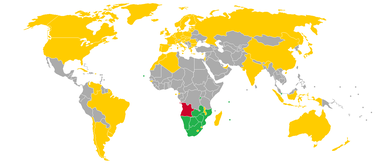
Entry requirements[edit]
Passport holders of the following countries do not need a visa to enter Angola when the purpose of the visit is tourism for up to 90 days (unless otherwise noted): Botswana, Mauritius, Mozambique, Namibia, Seychelles, Singapore, Zimbabwe.
From 30 March 2018, Angola started issuing tourist visas valid for 30 days in a simplified procedure to visitors from the following 59 countries: Algeria, Argentina, Australia, Austria, Belgium, Brazil, Bulgaria, Canada, Cape Verde, Chile, China, Croatia, Cuba, Cyprus, Czech Republic, Denmark, Estonia, Eswatini, Finland, France, Germany, Greece, Hungary, Iceland, India, Indonesia, Ireland, Israel, Italy, Japan, Republic of Korea, Latvia, Lesotho, Lithuania, Luxembourg, Madagascar, Malawi, Malta, Monaco, Morocco, Netherlands, New Zealand, Norway, Poland, Portugal, Romania, Russia, Sao Tome and Principe, Slovakia, Slovenia, Spain, Sweden, Switzerland, Timor-Leste, United Arab Emirates, United Kingdom, United States of America, Uruguay, Vatican City, Venezuela and Zambia.
Visitors must first apply for a pre-visa online[dead link] with the Migration and Foreigners Service and after such pre-visa is granted they can obtain a visa on arrival at Luanda Airport. In order to obtain a pre-visa applicants must submit proof of accommodation and subsistence means, a return ticket and the international certificate of vaccination. Visa costs US$120, paid on arrival.
When obtaining a visa from countries to the north, you will often only be issued a 5-day transit visa for Angola. If travelling by road, this will only give you enough time to get to Luanda where it takes up to 4 days to get another five day transit visa. If you're coming into Angola from the DR Congo, you may well need an Angolan visa before entering DR Congo.
By plane[edit]
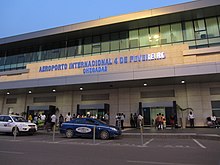
Luanda-4-de-Fevereiro is situated 4 km outside Luanda. There are public phones and bank facilities at the airport.
The most reliable taxi system from the airport is Afritaxi. Their white vehicles are clearly marked, and they charge per km or per minute, depending on how bad traffic congestion is. They only operate during daylight hours. Eco Tur also runs reliable airport transfers, but you'll need to book in advance.
- TAAG Linhas Aereas de Angola has flights between Luanda and some states in Africa, for example to South Africa (Johannesburg), Namibia (Windhoek), Zimbabwe (Harare), Democratic Republic of the Congo (Kinshasa) and the Republic of Congo (Brazzaville). TAAG has three weekly flights to Rio de Janeiro (Brazil).
- Air France flies from Paris
- Airlink flies directly from Johannesburg
- British Airways offers direct connections between London
- Brussels Airlines[dead link] flies from Brussels.
- Emirates flies directly from Dubai
- Ethiopian Airways flies from Addis Ababa
- Lufthansa[dead link] flies from Frankfurt.
- Iberia flies from Madrid.
- Kenya Airways from Nairobi
- Qatar Airways from Doha
- TAP Air Portugal[dead link] flies daily from Lisbon
- TAME[dead link] flies from Conakry
By train[edit]
There are no railway links between Angola and other nations.
By car[edit]
You can go in from Namibia at the border post near Oshikango(Namibia)/Ondjiva(Angola).
Entering from the North was, as of 2002, via Luvo, a small town on the Kinshasa-Matadi 'road'. If you want to drive through Angola, it's a real experience. Off the beaten track, road conditions might not be quite what you are used to so be prepared, particularly during the rainy season where potholes are likely to be a frequent occurrence. Also, keep a look out for livestock and the overloaded vehicles of the Angolan residents.
By bus[edit]
There are no bus links between Angola and other nations.
By boat[edit]
As of 2003, it was at least possible to enter Angola via a small passenger ferry near Rundu in Namibia. There was both an Angolan and Namibia border official present. The crossing was mostly used by Angolans for the purposes of acquiring food and other supplies in Namibia. There are (as of 2007) ferries running from the enclave of Cabinda to Luanda, which can be useful to avoid the unstable DR Congo. They carry cars as well. Seek local advice for when they depart. Sources claim that they run twice a week, cost $180 per person (bike included), and take 14 hours to do the trip (2005).
If there are no ferries, there might be cargo planes that you (and your car) can ride on between Cabinda and Luanda [1]. Be warned - these planes are unsafe. Use them at your own peril.
Get around[edit]
By bus[edit]
There are some bus private companies which offer services as MACOM and SGO being the biggest ones. Those companies offer a wide range of services dealing with locations one wants to travel, especially inter-provincial courses. There are lines that connect most of the major cities of the country, from the coast to the interior. Local minibus transport is not safe.
By train[edit]

Angola’s rail system is finally being restored with the help of Chinese firms after more than 30 years of disuse. There are three main lines reflect the country's colonial past, running from the resourceful interior to the coast. They do not connect with each other.
- The northern line Caminho de Ferro de Luanda (CFL) between the capital Luanda and Malenje is back to full service. There are three classes, Primeira, with reclining leather seats with individual television sets; Exspresso, with comfortable chairs arranged in fours around tables and communal televisions; and Tramway, the cheapest option fitted out with benches to maximize passenger numbers. Ticket prices hover around 2,500 kwanzas ($26; £17). Carriges are clean and modern carriages with functioning toilets and a restaurant car. There are daily departures.
- The middle line, Caminho de Ferro de Benguela (CFB) have just started services between Lobito, Cubal and Huambo with some trains continuing to Luau at the border with Democratic Republic of Congo. There are several departures per week.
- The southern route Caminho de Ferro de Mocamedes (CFM) runs between Namibe, Lubango and Menongue.
By ferry[edit]
A passenger ferry links Luanda with the oil port of Soyo and the enclave of Cabinda. Timetables and operators haft shifted over the years, inquiring directly at the harbor is probably the easiest way to get information.
By plane[edit]
TAAG Angola Airlines offers scheduled flights around the country departing from Luanda to Cabinda, Catumbela, Dundo, Harare, Huambo, Kuito, Lubango, Luena, Menongue, Moçâmedes, Ondjiva, Saurimo, Soyo and Uíge
By car[edit]
The main roads in Luanda and the provinces are in relatively good condition. However, during the rainy season (November to April), bridges and even roads can be washed away by water. When travelling outside Luanda, travel with someone who knows the local conditions, as conditions can be difficult. When travelling in rural areas, beware of landmines. There may be a shortage of petrol. Avoid driving after dark.
See[edit]
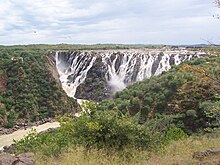
In Luanda: the Mussulo island for clean tropical beaches and water sports, the Benfica Market for Kwanza River.
Eco Tur Angola do various bespoke no tours Angola including Kissama with specialist game viewing vehicles.
In Benguela: Baia Azul for beautiful desert beaches. Art deco architecture in Benguela. Lobito City for the Restinga Peninsula and ice cold draught Cuca beer, the Benguela Rail road, and fantastic scenery.
In Kwanza Sul - Cubal Canyon, Conde Hot springs and Cachoeiras and Binga Waterfalls, with the Cambambe Dam on River Kwanza. Waku Kungo plains has fantastic scenery.
In Malange - Kalandula Waterfalls and Pungo n'Dongo Black Stones.
In Huila - Serra de Leba, Tunbda Vala Gorge, Mumuila tribespeople, fantastic scenery.
In Namibe - Arco Lagoon, beaches and a desert, and Mucubais tribespeople.
In Huambo - City Tours, Alto Hama hot springs, and fantastic scenery.
In Cunene - Himba tribes people, Ruacana Falls, and fantastic scenery.
Do[edit]
Buy[edit]
Money[edit]
|
Exchange rates for Angolan kwanzas As of January 2024:
Exchange rates fluctuate. Current rates for these and other currencies are available from XE.com |
The currency of Angola is the Angolan kwanza, denoted by the symbol "Kz" (ISO code: AOA). It used to be prohibited to import or export any sum of kwanza, but now you can carry up to Kz50,000 out of the country. The kwanza (sometimes called the "new kwanza") replaced the kwanza reajustado at a rate of 1000:1 in 1995. The kwanza reajustado had replaced the novo kwanza at a rate of 1,000,000:1 in 1990. Watch out for old notes and coins.
Coins of Angola are issued in denominations of 10 and 50 cêntimos, 1, 2, 5, 10, 20, 50 and 100 kwanzas. Banknotes of Angola are issued in denominations of 1, 5, 10, 50, 100, 200, 500, 1,000, 2,000 and 5,000 kwanzas.
The kwanza lost 2/3 of its value against other currencies in 2023; prices in articles may not reflect recent inflation.
Shopping[edit]
Just south of Luanda, the Benfica Handcrafts Market offers the best prices for handicrafts and souvenirs. This is an open market where local artists and artisans display their products, and bargaining is not only acceptable, but recommended. The products range from sculptures and paintings to jewellery, batik cloths and accessories.
Eat[edit]

Generally, dining out is not very easy in Angola, since even in Luanda restaurant food is expensive and many of the less well equipped restaurants have poor hygiene. Nonetheless, Angolan cuisine is varied and tasty, with local dishes based mainly on fish, cassava products and spicy stews.
Angolan seafood is abundant and very good, and the Angolan coast is a special place to eat fresh lobster right off the fisherman's boat.
Tropical fruit in Angola is also a treat because artisan production has maintained organic methods so that rich fruit flavours, unusual to the Western palate accustomed to industrially produced tropical fruits, predominate. If, however, you are situated in Luanda and need to dine, it is recommended that you get to Ilha de Luanda, where beach-restaurants (of varying price-classes from very exclusive to rather informal) can serve most foreign needs. Restaurants in Luanda grew in numbers and quality after the 2002 ceasefire brought stability and significant investment to the country.
Be careful: when eating out, do not drink tap water, ask for bottled mineral water instead.
Not all restaurants accept US dollars in cash; ask before ordering. Credit cards will not be accepted at most restaurants, although that is rapidly changing.
Signature and national dishes[edit]
- Doro Wat
- Muamba de galinha (Chicken Muamba)
- Mufete de cacusso - fish rubbed with fresh lemon and pepper
- Mufete - grilled fish of your choice (type of fish subject to availability) with boiled sweet potatoes and a mixture of raw finely chopped onions, peppers and tomatoes. Locals like to add beans as a side dish.
- Calulu a maneira com Funge de bombo
- Pirão ou funge - polenta made of corn meal and cassava roots. It is also served as the main meal in homes during Christmas.
Drink[edit]
Sleep[edit]
World class hotels include the Tropico Hotel, the Alvalade Hotel, Le President Meridien Hotel, the Continental Hotel, the Skyna Hotel, the Epic Sana hotel, and the Palm Beach Hotel, among others.
Stay safe[edit]
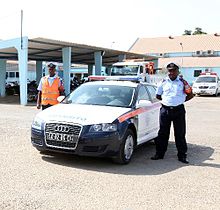
You should consider hiring a trusted and knowledgeable local guide for travel within Angola, although if you follow some basic rules then travelling in Angola isn't dangerous. Travelling after dark and alone is never a good idea. If possible, join with several cars of the same make and model because of the possible need of spare parts.
Never step beyond the red and white HALO Trust posts. These denote mine fields. In fact, beware of anything surrounded by any kind of red stones or similar markers.
In Angola, it is mandatory to have a form of identification on you at all times. What this means: carrying a certified copy of your passport or your national identification card.
Crime[edit]
- See also: Travel in developing countries
Angola has a high crime rate. Carjackings, muggings, robberies, sexual assaults, and the like are not unheard of in the capital city, Luanda.
Being a tourist will, undoubtedly, make you an "easy" target for criminals. Having little to no knowledge of Portuguese will also make you stand out. You can drastically reduce the likelihood of being a crime victim by applying a modicum of common sense — don't display signs of affluence, don't flash around your gadgets, keep your valuables and belongings out of reach, don't go to unfamiliar areas, don't go out at night, dress conservatively, and don't be too trusting of people you don't know.
If you've been sexually assaulted, immediately seek medical attention; Angola has a high HIV/AIDS prevalence rate.
Political unrest[edit]
Angola has a long history of political instability and unrest.
Be careful with voicing your political opinions in public or on social media; disrespecting government officials is a punishable offence in Angola. This also encompasses complaining about how government officials and authorities are carrying out their duties.
Photography[edit]
Given Angola's history of enduring civil conflict, perceived threats to national security are taken very seriously in Angola. Taking photographs of certain structures and individuals — government buildings, military installations, train stations, police officers, airfields, airports, and bridges — will land you in serious trouble with the Angolan authorities and they may (incorrectly) assume you're a spy or a terrorist.
Stay healthy[edit]
State-of-the-art medical care is virtually non-existent in Angola; the country has one of the lowest average life expectancies in the world, the country is ideal for many tropical diseases, and a significant portion of Angolans are too poor to afford healthcare.
Malaria is the leading cause of death in the country. Regularly use insect repellent to lower your chances of contracting malaria, and consider draping a mosquito net (if you have one) over your bed. It's strongly recommended to get vaccinated against malaria before travelling to Angola.
Do not drink tap water. There is no working water purification system in Angola. Stick to bottled water.
Yellow fever is prevalent in the country. You are normally required to get vaccinated against the disease before applying for an Angolan visa and/or travelling to the country.
Dengue fever is another major health threat.
The country's HIV/AIDS prevalence rate among adults is 1.80%. Although it is low compared to other African nations, you should always be aware of your surroundings.
Respect[edit]
Since Angola is rarely visited by tourists, you may attract unwanted attention from the locals. This isn't to indicate hostility, it is to indicate curiosity.
As is the case throughout Africa, it is obligatory to show respect for elders (including authority figures) as they're generally viewed as wiser and more experienced. When visiting an Angolan home, it is customary to greet the oldest person first. If you're waiting to enter a building, allow someone older to go in first. If you're on public transportation, give up your seat for someone older than you.
Angolans are extremely hospitable and they consider it impolite to not give someone a good welcome. Therefore, you can expect to be treated with immense respect as a visitor. If you've been invited for a meal at an Angolan person's home, bear in mind that the oldest person in the house starts eating first.
Angolans are attentive listeners. They consider it extremely rude to interrupt someone's conversation.
If travelling to rural areas, take some time to greet the local soba (chief with government-backed authority). Words of kindness will allow you to enjoy your journey in peace.
Angolans are generally amiable, and it is important to greet everyone respectfully and immediately upon seeing them. A simple hello ("Bom dia") will do.
Connect[edit]
The phone country code of Angola is +244. Telephone connections, cellular and landline, are heavily overloaded, making communication difficult at times. International lines are, however, often better.
Carry a satellite telephone in the case of a breakdown or other emergency. Be aware, that while Iridium [2] satellite phones have global coverage, Thuraya satellite phones have coverage in most of Angola, but may not have coverage in the southern parts of the country.

